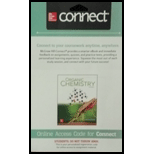
Concept explainers
Interpretation: The reason as to why both C and D absorb light in the UV region of the
Concept introduction: Most of the organic structures cannot be represented using single Lewis structure. Therefore, there exists more than one Lewis structure for representing a molecule or ion. These structures are known as resonance structures. These are the hypothetical structures and do not specify the exact structure. These resonance structure combine together to give resonance hybrid that is lower in energy and is the most stable structure.
The delocalization of electrons results in the formation resonance structure.
Want to see the full answer?
Check out a sample textbook solution
Chapter 16 Solutions
Connect Access Card Two Year for Organic Chemistry
- a. How many linear dienes have molecular formula C6H10? (Disregard cis–trans isomers.) b. How many of the linear dienes in part a are conjugated dienes? c. How many are isolated dienes? d. How many are cumulated dienes?arrow_forwardWhat hybridization best describes the reacting carbon in the SN2 transition state?arrow_forward3. What is the difference between the reaction conditions to obtain kinetic and thermodynamic products in the reactions of dienes?arrow_forward
- Classify the following dienes and polyenes as isolated, conjugated, cumulated, or some combination of theseclassifications.(a) cycloocta-1,4-diene (b) cycloocta-1,3-diene (c) cyclodeca-1,2-dienearrow_forwardLabel each diene as reactive or unreactive in a Diels–Alder reactionarrow_forwardConsider the following 2 dienes. When treated with HBr, one of these dienes yields four products while the other diene yields only two products. Explain.arrow_forward
- The Diels–Alder reaction, a powerful reaction, occurs when a 1,3-diene such as A reacts with an alkene such as B to form the six-membered ring in C. Question: What bonds are broken and formed in this reaction?arrow_forwardClassify the following dienes and polyenes as isolated, conjugated, cumulated, or some combination of theseclassifications.(a) cycloocta-1,4-diene (b) cycloocta-1,3-dienearrow_forwardExplain the Stability of Allylic Carbocations ?arrow_forward
- A2 What is the inverse electron demand Diels–Alder reaction? Please pick a pair of a diene and a dienophile from the following dienes and dienophile that will undergo this type of reaction. Please show how this reaction works using Frontier Molecular Orbitals. What is the reaction product?arrow_forwardDiels—Alder reaction of a monosubstituted diene (such as CH2 = CH – CH = CHOCH3) with a monosubstituted dienophile (such as CH2 = CHCHO) gives a mixture of products, but the 1,2-disubstituted product often predominates. Draw the resonance hybrid for each reactant and use the charge distribution of the hybrids to explain why the 1,2-disubstituted product is the major product.arrow_forwardcis-1-Bromo-4-tert-butylcyclohexane and trans-1-bromo-4-tert-butylcyclohexane both react with sodium ethoxide in ethanol to form 4-tert-butylcyclohexene. Explain why the cis isomer reacts much more rapidly than the trans isomer.arrow_forward

 Organic ChemistryChemistryISBN:9781305580350Author:William H. Brown, Brent L. Iverson, Eric Anslyn, Christopher S. FootePublisher:Cengage Learning
Organic ChemistryChemistryISBN:9781305580350Author:William H. Brown, Brent L. Iverson, Eric Anslyn, Christopher S. FootePublisher:Cengage Learning

